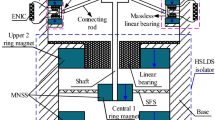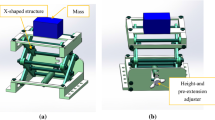Abstract
The frequency range over which a mount can isolate a mass from a vibrating base (or vice versa) is often limited by the mount stiffness required to support the weight of the mass. This compromise can be made more favourable by employing non-linear mounts with a softening spring characteristic such that small excursions about the static equilibrium position result in small dynamic spring forces and a correspondingly low natural frequency. This paper concerns the force-displacement characteristic of a so-called quasi-zero-stiffness (QZS) mechanism which is characterised by an appreciable static stiffness but very small (theoretically zero) dynamic stiffness.
The mechanism studied comprises a vertical spring acting in parallel with two further springs which, when inclined at an appropriate angle to the vertical, produce a cancelling negative stiffness effect. Analysis of the system shows that a QZS characteristic can be obtained if the system’s parameters (angle of inclination and ratio of spring stiffnesses) are opportunely chosen. By introducing the additional criterion that the displacement of the system be largest without exceeding a desired (low) value of stiffness an optimal set of parameter values is derived. Under sufficiently large displacements the stiffness of the QZS mechanism can eventually exceed that of the simple mass-spring system and criteria for this detrimental scenario to arise are presented.
Similar content being viewed by others
References
Den Hartog, J. P., 1956,Mechanical Vibrations, McGraw-Hill, New York.
Rivin, E. I., 2001,Passive Vibration Isolation, ASME Press.
Alabuzhev, P., Gritchin, A., Kim, L., Migirenko, G., Chon, V. and Stepanov, P., 1989,Vibration Protecting and Measuring Systems with Quasi-Zero Stiffness, Hemisphere Publishing, NY.
Platus, D. L., 1991, “Negative-Stiffness-Mechanism Vibration Isolation Systems,”SPIE-Vibration Control in Microelectronics, Optics and Metrology Vol. 1619, pp. 44–54.
Zhang, J., Li, D. and Dong, S., 2004, “An Ultra-low Frequency Parallel Connection Nonlinear Isolator for Precision Instruments,”Key Engineering Materials, Vol. 257–258, pp. 231–236.
Denoyer, K. and Johnson, C., 2001 “Recent Achievements in Vibration Isolation Systems for Space Launch and On-orbit Applications,”52nd International Astronautical Congress, Toulouse, France.
Dankowski, J., 2001, “State of the Art Vibration Isolation of Large Coordinate Measuring Machine with an Adverse Environment,”2nd Euspen International Conference, Turin, Italy.
Carrella, A., Brennan, M. J., Waters, T. P., 2006, “Optimisation of a Passive Vibration Isolator with Qusi-Zero-Stiffness Characteristic,”ISVR Technical Memorandum, No. 960, Institute of Sound and Vibration Research, University of Southampton.
Author information
Authors and Affiliations
Corresponding author
Rights and permissions
About this article
Cite this article
Carrella, A., Brennan, M.J. & Waters, T.P. Optimization of a quasi-zero-stiffness isolator. J Mech Sci Technol 21, 946–949 (2007). https://doi.org/10.1007/BF03027074
Received:
Revised:
Issue Date:
DOI: https://doi.org/10.1007/BF03027074




